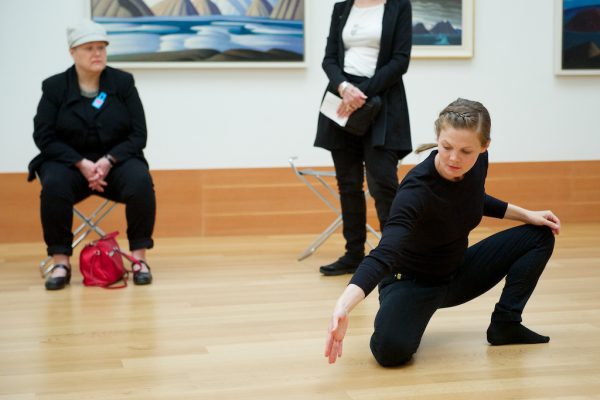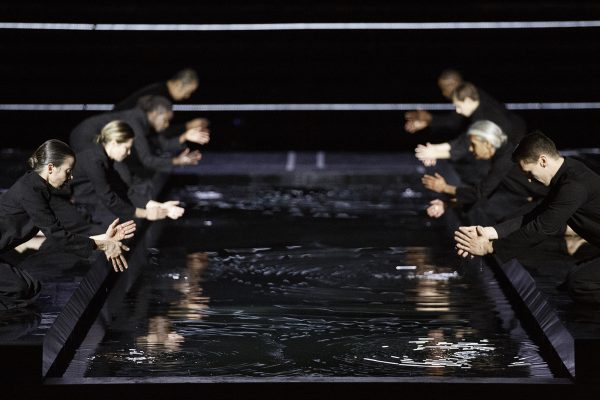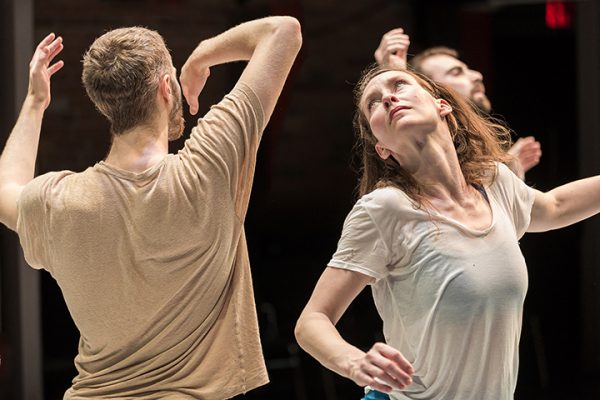It’s Friday afternoon on September 22, and Peggy Baker is at a loss for words. Indeed, she seems tearful. Baker embraces a radiant, sweaty dancer — Belinda McGuire — and says to the gathered audience, “I’m never going to forget this.” “This” is Waltz and Slaughterhouse/Requiem, a double bill of powerful and compelling solo work danced by McGuire. Both works are world premieres presented by NextSteps at Harbourfront Centre’s Fleck Theatre. The program is masterfully constructed — Sylvain Émard’s Waltz sits comfortably beside Belinda McGuire’s own Slaughterhouse/Requiem. These works are compatible yet contrasting, like well-paired wine and cheese. The dances share themes of loss, introspection and melancholy, while sharply contrasting in execution and design.
Waltz is the first work on the bill. It begins with delicate, precarious movement in a warm pool of light. McGuire folds to pick up her foot and guide it to a balancing pose. She extends her arms above her, unfolding into such an immense shape it seems her limbs are growing even longer. As grinding and hissing sounds crescendo, more pools of light illuminate the dark space, and McGuire begins to move as if battered by a tempest. Perhaps she embodies the maelstrom — she flexes her feet, grasps her face with her hands, kicks, turns and falls to the floor. She is abruptly and shockingly still.
The music, composed by Martin Tétreault, mirrors the inner landscape of the dancer with rhythmic waves of static, layers of intense noise and sudden silence. The turbulent minimalism of Tétreault’s sound is supported by François St-Aubin’s costume design and André Rioux’s lighting. McGuire is draped in a black mesh dress with dark undergarments, exposing bare limbs, subtly revealing her sinuous power. In the dim light, McGuire’s skin often appears to glow, generating a delicate sense of vulnerability. The waves of movement, sound and the gentle darkness together immerse the viewer in an environment filled with human emotion. There is a sense of unmooring from linear time; we become disoriented as time overlaps. It seems McGuire is reliving the past while experiencing sensations in the present. McGuire waltzes with the human condition, with awe and loss, sensation and recollection in equal balance.
The second work, Slaughterhouse/Requiem, is part elegy, part monument. A large, free-standing frame seems to float in the dark, centre stage. Advancing into the light behind this frame, McGuire materializes and then disappears. This first image is haunting and spectral. McGuire soon reappears and steps through the frame. She is wearing a corset of chicken wire with black feathers that descend to the floor, moulting as she moves. She is also wearing grey shorts and a grey tank top with the image of a human figure on the front and the back. McGuire dances to music by Arvo Pärt, Michael Gordon and Alfredo de Angelis.
The work begins with choral, classical reverence. Its movement phrases are spacious, full of breathy suspension, reach, spiral and elasticity. Weighted hands, feet and head swing and drop, propelling great travelling steps through the space.
At first blush, Slaughterhouse/Requiem appears over-elaborate — starkly contrasting the elegant minimalism of Waltz. There are more chicken wire corsets, some with feathers and some trailing white string. They are piled and thrown across the space. They are attached into trains McGuire pulls like metaphorical baggage behind her — they are shells, cast-offs or, more darkly, carcasses. A puppet-like doll appears midway with the same costume and hair as McGuire. There is even a plaster cast of a face, appraising the chaos with a sense of serene judgment. These objects accumulate like an elephant’s graveyard as they are placed, strewn and revealed. McGuire assembles these artifacts and it is hard to understand what she is doing, at least conceptually. Is she building a living and constructed monument to herself? Are the scenic elements a search for meaning or an examination of the evidence? Is this deluge of scenic design purposeful in its extensiveness?
There is deep meaning here. These artifacts were built by McGuire and reference many selves. Indeed, in the middle of the work, deceptively simple shadows of McGuire appear behind her in projections designed by Michael F. Bergmann. They dance with her, behind her and around her as a grouping of selves — repeated like a manifestation of accumulating time, or past and future identities. The work is both defying and accepting mortality, loneliness and loss. It faces the inevitable failure of the human body, which will itself become another inanimate artifact. There is great courage and melancholy here. Although the set, music and projection are imposing, the dancing is not overshadowed. McGuire’s body channels a poised and direct energy; she conveys remarkable emotional resonance through subtle facial expression.
In sum, there is towering presence to this program of work. These solos are immense in a way that is reminiscent of ballet or even opera. Expansive movement, immense sounds and carefully crafted, elaborate scenic design makes the scale seem larger than life. This “bigness” has a layer of complexity. As solos, the works also convey a sense of privacy, urgency and immediacy that is intensely personal. McGuire’s skill as a performer is to tap a depth of feeling that is universally human, while remaining resolutely individual — springing from her own life, her body, her experience. Ultimately, these works are gloriously danced.
Tagged: Contemporary, ON





